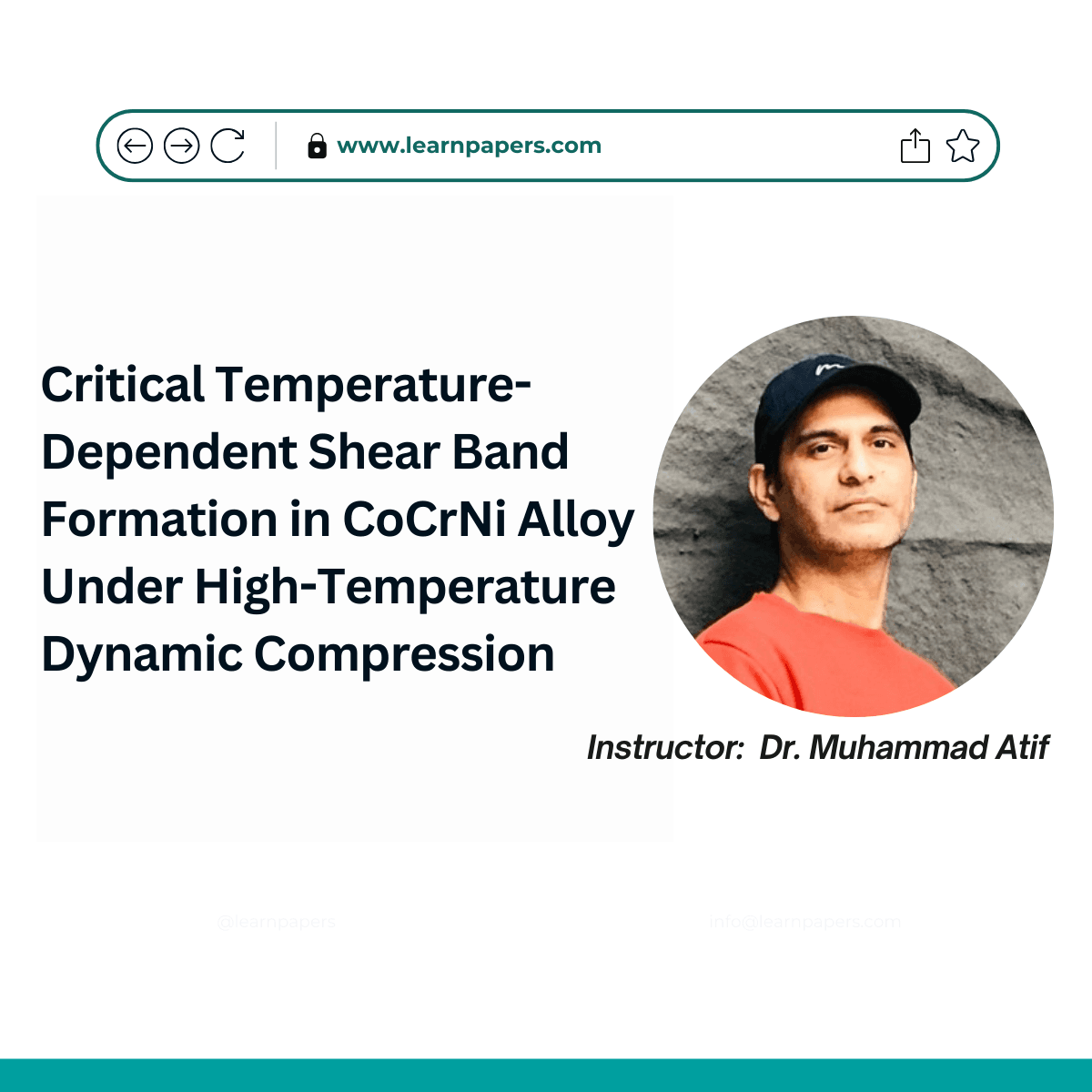Critical Temperature-Dependent Shear Band Formation in CoCrNi Alloy Under High-Temperature Dynamic Compression

About Course
Understanding material behavior under extreme conditions is crucial in industries such as aerospace, automotive, and defense. This course delves into the critical temperature-dependent shear band formation in CoCrNi alloys, an area of growing interest in material science and engineering. With advancements in high-entropy alloys (HEAs), the study of shear localization and mechanical instability under dynamic compression is more relevant than ever.
This course provides an in-depth exploration of the mechanical response of CoCrNi alloys under high-temperature and high-strain rate conditions. Learners will gain valuable insights into the fundamental principles of dynamic compression, microstructural evolution, and failure mechanisms that impact material performance. Through detailed theoretical discussions, experimental analysis, and real-world applications, participants will develop a strong foundation in understanding how materials behave under extreme loading conditions.
By enrolling in this course, learners will gain a comprehensive understanding of high-entropy alloys and their significance in modern engineering applications; Learn about the experimental techniques used to study shear band formation, including EBSD, SEM, TEM, and DSC analysis; Analyze the microstructural changes that occur in CoCrNi alloys under dynamic loading; Understand the impact of strain rate, temperature, and stored energy on mechanical performance and stability; Apply the course concepts to practical scenarios in impact resistance, crashworthiness, and high-temperature material applications.
Whether you are a materials scientist, mechanical engineer, or industry professional, this course will provide you with essential knowledge and skills to advance your expertise in dynamic material behavior. Join us on this journey to explore the complexities of shear band formation and high-temperature alloy performance!
Reference Link
https://www.sciencedirect.com/science/article/abs/pii/S0925838824016153?via%3Dihub
What Will You Learn?
- The fundamental principles of material science and metallurgy, with a focus on high-entropy alloys like CoCrNi.
- The effects of dynamic compression and high-temperature conditions on material behavior.
- The factors influencing shear band formation, including strain rate, temperature, and stored energy.
- The role of microstructural changes such as deformation twins, dislocations, and recrystallization in mechanical stability.
- Experimental techniques such as EBSD, SEM, TEM, and DSC for analyzing material performance under extreme conditions.
- The relationship between grain size, mechanical properties, and shear localization.
- The practical applications of CoCrNi alloys in aerospace, automotive, and defense industries.
- How to interpret experimental data and compare it with computational modeling for material performance analysis.
- The influence of temperature-dependent mechanical instability on structural integrity and impact resistance.
- Emerging research trends in high-temperature materials and their future industrial applications.
Course Content
Module 1: Introduction to Material Science and High-Temperature Behavior
Fundamentals of material science and metallurgyImportance of high-entropy alloys (HEAs) in modern engineeringIntroduction to CoCrNi alloys and their mechanical propertiesOverview of shear band formation in materials under extreme conditions
Module 2: Principles of Dynamic Loading and Shear Band Formation
Understanding dynamic compression and its effects on materialsFactors influencing shear band formation: strain rate, temperature, and microstructureThe role of stored energy and work hardening in mechanical stabilityExperimental methods used to study dynamic compression
Module 3: Microstructural Evolution in CoCrNi Alloys Under Dynamic Loading
Initial microstructure and mechanical properties of CoCrNi alloysImpact of thermomechanical processing on material behaviorRole of deformation twins, dislocations, and stacking faults in microstructural changesUnderstanding recrystallization and its influence on shear band formation
Module 4: Experimental Analysis of Shear Band Formation
High-temperature dynamic compression testing techniquesMicrostructural characterization using EBSD, SEM, and TEMThermal analysis methods: Differential Scanning Calorimetry (DSC)Influence of grain size and stored energy on adiabatic shear band (ASB) formation
Module 5: Mechanical Performance and Failure Mechanisms
Strength, ductility, and fracture behavior of CoCrNi alloysTemperature-dependent mechanical instability and critical temperature effectsComparison of experimental results with computational modelingApplication of findings in impact and crashworthiness scenarios
Module 6: Practical Applications and Future Research Directions
Application of CoCrNi alloys in aerospace, automotive, and defense industriesEnhancing impact resistance and mechanical stability of alloysFuture research directions in high-temperature dynamic materialsSummary and final assessment of key learnings
Final Assessment:
Multiple-choice quiz covering theoretical conceptsPractical project: Analyzing the impact of temperature and strain rate on shear band formationDiscussion forum participation to share insights and findings
Additional Resources:
Research papers on shear band formation and high-temperature material behaviorTutorials on using microstructural analysis tools (EBSD, SEM, TEM)Case studies on HEAs in extreme conditions
Student Ratings & Reviews
